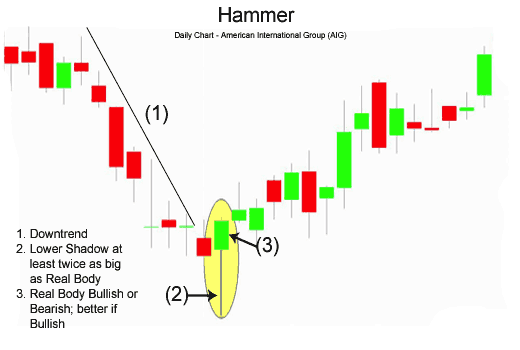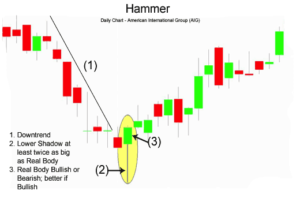Hammer Candlestick Pattern

The Hammer candlestick formation is viewed as a bullish reversal candlestick pattern that mainly occurs at the bottom of downtrends.
The Hammer formation is created when the open, high, and close are roughly the same price. Also, there is a long lower shadow, twice the length as the real body.
When the high and the close are the same, a bullish Hammer candlestick is formed and it is considered a stronger formation because the bulls were able to reject the bears completely plus the bulls were able to push price even more past the opening price.
In contrast, when the open and high are the same, this Hammer formation is considered less bullish, but nevertheless bullish. The bulls were able to counteract the bears, but were not able to bring the price back to the price at the open.
The long lower shadow of the Hammer implies that the market tested to find where support and demand was located. When the market found the area of support, the lows of the day, bulls began to push prices higher, near the opening price. Thus, the bearish advance downward was rejected by the bulls. Hammer Candlestick Chart Example The chart below of American International Group (AIG) stock illustrates a Hammer reversal pattern after a downtrend:
Hammer Candlestick Chart Example
The chart below of American International Group (AIG) stock illustrates a Hammer reversal pattern after a downtrend:

In the chart above of AIG, the market began the day testing to find where demand would enter the market. AIG’s stock price eventually found support at the low of the day. In fact, there was so much support and subsequent buying pressure, that prices were able to close the day even higher than the open, a very bullish sign.
The Hammer is an extremely helpful candlestick pattern to help traders visually see where support and demand is located. After a downtrend, the Hammer can signal to traders that the downtrend could be over and that short positions could potentially be covered.
However, other indicators should be used in conjunction with the Hammer candlestick pattern to determine potential buy signals, for example, waiting a day to see if a rally off of the Hammer formation continues or other chart indications such as a break of a downward trendline. But other previous day’s clues could enter into a traders analysis. An example of these clues, in the chart above of AIG, shows three prior day’s Doji’s (signs of indecision) that suggested that prices could be reversing trend; in that case and for an aggressive buyer, the Hammer formation could be the trigger to potentially go long.
The bearish version of the Hammer is the Hanging Man formation (see: Hanging Man). Another similar candlestick pattern to the Hammer is the Dragonfly Doji (see: Dragonfly Doji).
The information above is for informational and entertainment purposes only and does not constitute trading advice or a solicitation to buy or sell any stock, option, future, commodity, or forex product. Past performance is not necessarily an indication of future performance. Trading is inherently risky. Commodity.com shall not be liable for any special or consequential damages that result from the use of or the inability to use, the materials and information provided by this site.